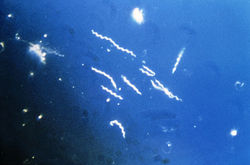Difference between revisions of "Borrelia burgdorferi"
Jump to navigation
Jump to search
| (12 intermediate revisions by 2 users not shown) | |||
| Line 1: | Line 1: | ||
| − | {{ | + | {{review}} |
| − | + | ||
| − | |||
| − | |||
| − | |||
| − | |||
| − | |||
| − | |||
| − | |||
| − | |||
| − | |||
[[File:Borrelia b.jpg|right|thumb|250px|<small><center> ''Borrelia burgdorferi''. (CDC 1993, Wikimedia commons)</center></small>]] | [[File:Borrelia b.jpg|right|thumb|250px|<small><center> ''Borrelia burgdorferi''. (CDC 1993, Wikimedia commons)</center></small>]] | ||
| − | |||
| − | |||
| − | |||
| − | + | ''Borrelia burgdorferi'' is a species of [[Borrelia species - Overview|''Borrelia'' bacteria]]. ''Borrelia'' species are longer, wider, helical [[Spirochaetes species - Overview|spirochaetes]]. | |
| − | + | The ''Borrelia burgdorferi'' sensu lato complex is the cause of '''[[Lyme disease]]'''. | |
| + | *''Borrelia burgdorferi'' sensu stricto, the most common cause of canine Lyme disease in the USA. | ||
| − | + | The bacteria are reported to infect humans, dogs, horses, cattle, sheep. | |
| − | |||
| − | |||
| − | |||
| − | |||
| − | |||
| − | + | Ticks are the vector for [[Lyme disease]], in particular, ''[[Ixodes spp.]]''. | |
| − | [[Category:Borrelia species]][[Category:Dog | + | [[Category:Borrelia species]][[Category:Dog]][[Category:Horse]][[Category:Cattle]][[Category:Sheep]] |
| − | [[Category: | + | [[Category:Expert_Review]] |
| + | [[Category:To_Do_-_AimeeHicks]] | ||
Revision as of 10:35, 26 July 2010
| This article has been peer reviewed but is awaiting expert review. If you would like to help with this, please see more information about expert reviewing. |
Borrelia burgdorferi is a species of Borrelia bacteria. Borrelia species are longer, wider, helical spirochaetes.
The Borrelia burgdorferi sensu lato complex is the cause of Lyme disease.
- Borrelia burgdorferi sensu stricto, the most common cause of canine Lyme disease in the USA.
The bacteria are reported to infect humans, dogs, horses, cattle, sheep.
Ticks are the vector for Lyme disease, in particular, Ixodes spp..
